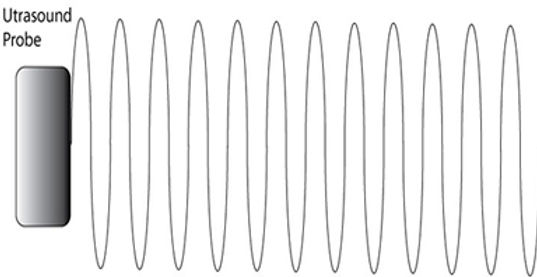Beam Parameters
Pulsed ultrasound is used to generate two dimensional images, pulse wave spectral Doppler and color Doppler images. With pulsed ultrasound, the transducer generates a pulse composed of several cycles of ultrasound at given wavelength and frequency. The transducer then listens for reflected ultrasound returned to the transducer. Thus, pulsed ultrasound requires a minimum of one transducer element. Because the transducer can calculate the time difference between sound emitted and reflect sound detected, pulsed ultrasound allows for range resolution. However, pulsed ultrasound is subject to aliasing.
This schematic shows the typical model of pulses ultrasound. The probe sends out a pulses of a signal at a prespecified freuquency. Each pulse contains a certain number of cycles of waves (4 in the case below). In between pulses there is listening time where the probe waits for signal to return to it to interpret. Note that the listening time is much much longer than the pulse duration, too long to shown on the diagram below, hence we use a notched line for listening time. For schematic purposes we will simplify the diagram for further illustrations shown below.

Pulse duration describes the time from the beginning to the end of the pulse. Pulse duration = period x # of cycles in the pulse

Spatial pulse length (SPL) describes the physical length of the pulse. SPL = wavelength x # of cycles in the pulse. Spatial pulse length is important as it determines axial resolution (discussed later)

Pulse repetition period describes the time from the onset of the pulse to the start of the next pulse. Thus the PRP = pulse duration + the listening time

Duty factor describes the percentage of the time that the transducer is emitting sound waves.
Duty factor = pulse duration/pulse repetition period.
For pulsed ultrasound systems, the duty factor is very low, reflecting the fact that the transducer spends much more time "listening" than emitting ultrasound. By way of comparison, the duty factor for continuous wave ultrasound is 1 reflecting the fact that one transducer element is always emitting ultrasound.
Continuous wave ultrasound which requires a minimum of 2 transducer elements. One transducer element is always transmitting while the second is always receiving. As a result, continuous wave ultrasound is not subject to aliasing but does lack range resolution.

Output power of the ultrasound system can be adjusted by the ultrasonographer to improve image quality. Note that the power an ultrasound system is measured in Watts and is related to the wave amplitude squared.
When confronted with a dark ultrasound image, it is tempting to increase the output power. However, increasing the power also increases the possibility of bioeffects and should be reserved for situations where these is low signal to noise in the image. Otherwise, receiver gain should be increased preferentially (see below).
Intensity is defined as power/beam area and is defined in units of watts/cm2. Intensity is the most important parameter in determining potential bioeffects.
Overall receiver gain is the degree to which the ultrasound waves returning to the transducer are amplified before being displayed. Increasing receiver gain is the preferred means of brightening an otherwise dark image as it has no impact on bioeffects. The exception is of course if the signal to noise ratio is low in which case one should increase output power.
Time gain compensation (TGC) or just compensation is a means of adjusting for the effect of attenuation at greater depth. This series of sliding switches on the echo machine allows the operator to increase the gain in a depth dependent manner to compensate for greater attenuation of ultrasound at greater depths. Newer ultrasound machines also allow for compensation in a horizontal fashion as well as with depth.